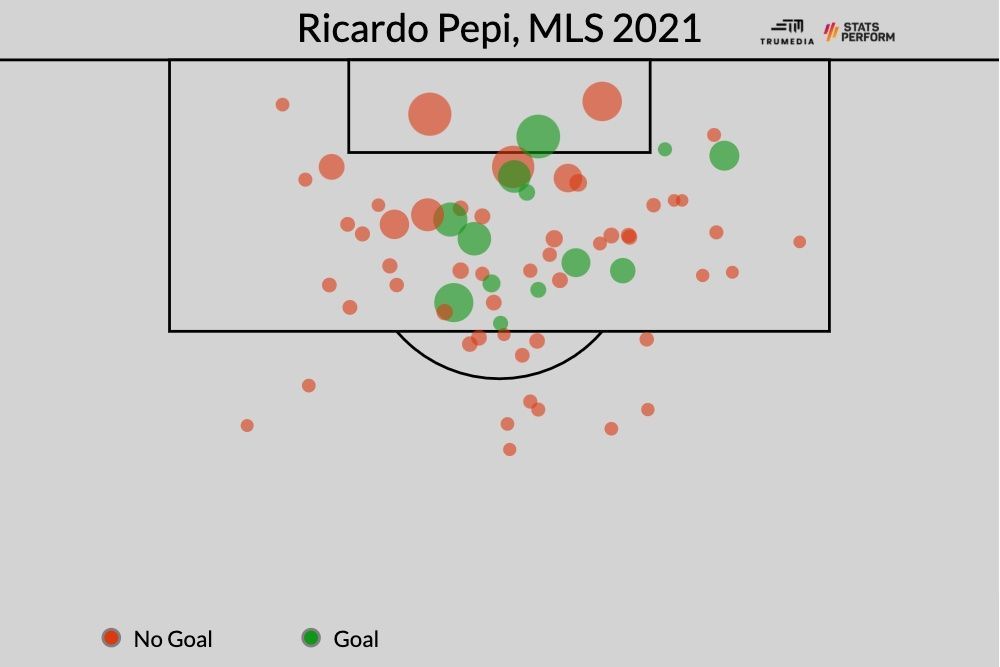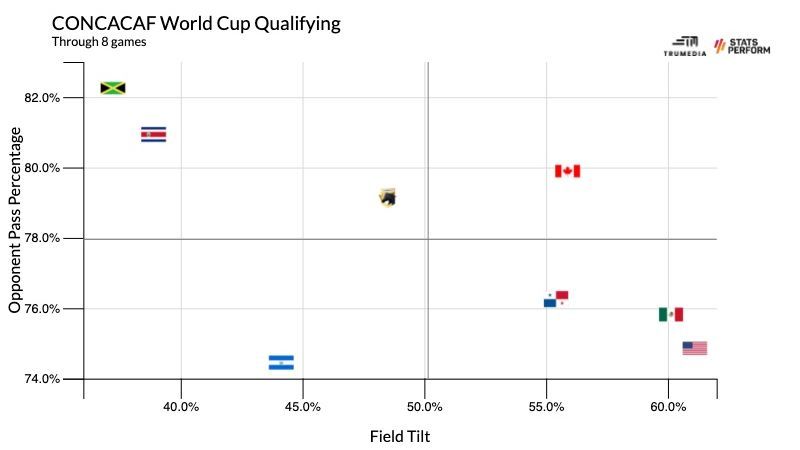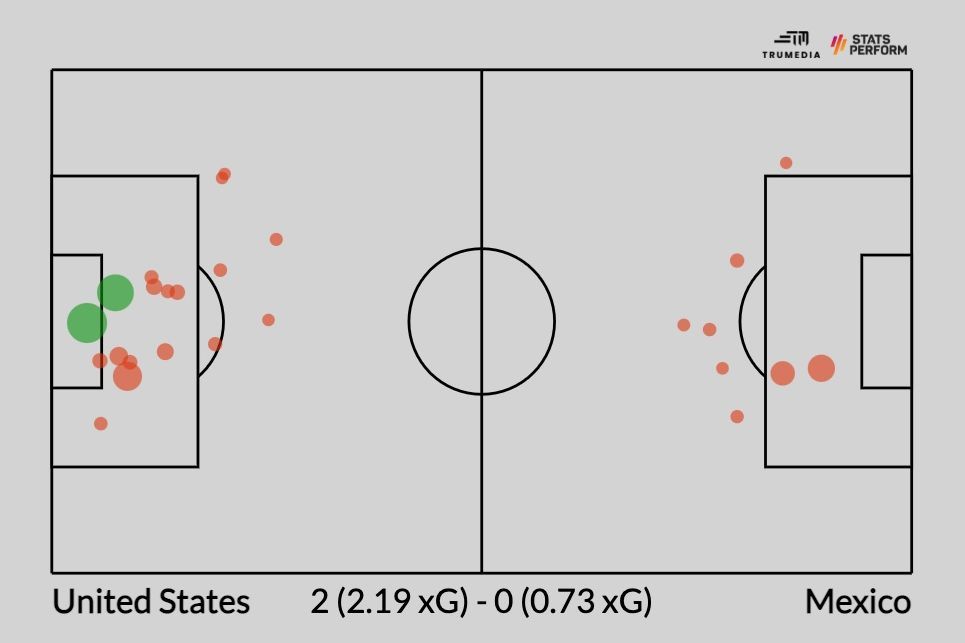Ahead of the U.S. men's national team friendly with Bosnia & Herzegovina this weekend (Saturday, 8 p.m. ET), Ryan O'Hanlon looks at the lessons learned and issues raised from the USMNT's performances in 2021 and casts ahead to give a sense of what this group needs to accomplish heading into the year of the World Cup.
What a weird year, huh? You can apply that to anything, of course, and the United States Men's National Team was no exception.
First, they scraped by Honduras at home in the semifinals of the Nations League, saved by a last-minute header from Jordan Pefok. Then they played Mexico toe-to-toe, came back multiple times, won 3-2 in extra time and got pelted by beers. Then their European stars all went home, but they won the Gold Cup anyway, beating Mexico in the final, again. And a full-strength Mexico, to boot: Napoli's Hirving Lozano, Ajax's Edson Alvarez, Atletico Madrid's Hector Herrera were all there!
It didn't seem to matter who was on the field. Gregg Berhalter's team were the kings of CONCACAF once again.
- ESPN+ viewers' guide: LaLiga, Bundesliga, MLS, FA Cup, more
- Stream ESPN FC Daily on ESPN+ (U.S. only)
- Don't have ESPN? Get instant access
And then... World Cup qualifying started. A scoreless draw at El Salvador? Sure, any road point is a good point. A tie at home with Canada? Hey man, Alphonso Davies is the best player in North America. A 1-0 halftime deficit in Honduras? Anyone have Bruce Arena's phone number? And then, as we all remember, they rolled off four goals in the final 45 for a three-goal victory. That was followed by a dominant win against Jamaica, and all was well again.
Psych! Then they got dominated in Panama, losing, 1-0 and... OK, you probably get the pattern now. Next was an easy win over Costa Rica, then was a truly dominant dos-a-cero against Mexico, and then was a wet fart in Jamaica that ended 1-1, but probably should've been a loss.
When it comes to the U.S. men, the sky is always falling, the team is always rising -- all at the same time. With one friendly left against Bosnia to go in 2021, it's been a successful, if chaotic, year for the USMNT. So, it's time to look ahead: What do we want to see from the team in 2022?
1. Just qualify, OK?
It doesn't matter how, JUST DO IT.
Right now, CONCACAF has four teams fighting for three automatic spots. With six games remaining, Canada's on 16 points, the U.S. on 15, and Mexico and Panama tied at 14. No-one else has more than nine points, and no-one outside of those four teams has a positive goal differential. But if the US somehow slips outside of the top three, they just need to avoid total collapse in order to finish fourth, which would mean a one-game playoff against the winner of the Oceania region: likely New Zealand.
Anything can happen in one match, but CONCACAF lucked out in drawing with Oceania, rather than Asia or South America. Even if they do fall down to fourth, the US should handle New Zealand quite easily. In the World Football Elo ratings -- an opponent- and competition-adjusted performance ranking -- the USMNT is 14th, while New Zealand is 72nd.
2. Get your best players on the field together, just one time!
The main reason to be hopeful of a better tomorrow for a team that hasn't reached the quarterfinals of a World Cup in two decades -- and, you know, missed the last one completely -- is the quality of the player pool. More specifically, it's because of five guys.
There's Christian Pulisic, Chelsea's $70 million man. There's Giovanni Reyna, who doesn't turn 20 for nearly another full year and has already started 32 Bundesliga and Champions League games for Borussia Dortmund. There's Sergino Dest, a starter at Ajax and then Barcelona. There's Weston McKennie, a starter with Juventus. And there's Tyler Adams, who scored a winning goal in the Champions League quarterfinals and has been one of Europe's best swiss-Army knives for RB Leipzig.
They're all 23 or younger. They're all consistently playing for some of the biggest clubs in the world. And they've never appeared on the field together for the USMNT.
3. Figure out the center-forward spot
Uh, what? We've got Ricardo Pepi, dude.
Pepi is a great... prospect. He's only 18, and he's already scored 15 goals and played more than 2,500 minutes for FC Dallas. Players who play that much and produce that often at a young age tend to turn out pretty well. But that's the future -- not now, when the U.S. still needs to qualify for, and then play in, a World Cup.
Over the past calendar year, per the site FBref, Pepi ranks in the 90th percentile of MLS strikers in non-penalty goals... and no other attacking-related categories. At the site American Soccer Analysis, they're created a stat called "goals added" (G+) that quantifies all of a player's on-ball actions to determine how much value he adds to the team. Over the past season, Pepi added minus-1.95 goals to FC Dallas. How? Because he scores some goals and just doesn't really contribute anywhere else on the field. Even his goal-scoring is a little inflated, too, as he's on a bit of a finishing hot streak: 13 goals on 10.1 xG.

In World Cup qualifying, it's been a similar story. He's scored three goals on 2.45 xG and he's averaging 28 touches per 90 minutes -- the fewest of all 34 players (including keepers) who have appeared in the Octagonal for the U.S. so far.
The wider tactical trend, too, is away from these kinds of "goals-only" center-forwards and toward more well-rounded players who contribute in all phases of play. Or: the kind of players the U.S. currently has lots of.
In addition to those five stars, Brenden Aaronson and Tim Weah are both playing significant minutes at Champions League clubs this season, and they've both spent time at center-forward for Red Bull Salzburg and Lille respectively. Pulisic has also moon-lit as a false 9 at Chelsea. None of them are pure goal scorers, but for the U.S., they're all getting on the ball as often, or more often, in the box than Pepi does.
With Pulisic and Reyna back in the picture, there might only be three attacking spots available between the two of them, Aaronson and Weah. That's four players, performing at a high level at the highest level. Should three goals in six games be enough to prevent Pepi from falling behind any of them in the pecking order?
4. Play one (1) normal game
Broadly speaking, the USMNT looks like a modern soccer team: they push the ball into the final-third and then keep it there by pressuring their opponents into turnovers. Through eight games, they've completed the largest proportion of final-third passes in their matches (known as "field tilt'') and only El Salvador has held its opponents to a lower pass-completion percentage.

This is who they were against Mexico. They pushed the field tilt to 62 percent, and they're the only team to hold El Tri below an 80-percent completion percentage. While the two trophy wins over Mexico were helter-skelter chaos, this was just controlled dominance: 18 shots to 8.

But despite that game's characteristics hewing closer to the team's average qualities, it's really the only match that's looked like that. The opener against El Salvador was a wild track meet, where the U.S.'s average uninterrupted possession lasted for 5.4 seconds and 44 percent of their passes were played forward -- the shortest time and most passes across the eight matches.
In the next match against Canada, the possessions lasted for 12.5 seconds and they played 25 percent of their passes forward -- longest and least across the eight matches. And against Honduras, the field was tilted toward their opponents (45 percent for the US). Against Jamaica, the match featured just 87 possessions, compared to an average of 95 across all the games. Against Panama, that dipped down to 84 as the U.S. played a bunch of long balls and allowed their opponents to complete over 80 percent of their passes.
Things looked pretty good against an ancient Costa Rica team and Mexico, before the re-match with Jamaica, where the US allowed a PPDA (essentially, opponent passes allowed per defensive action in your attacking third) of 26.63. Their average across the eight games is 9.92.
Do you want to press and possess? Do you want matches where the ball is turning over constantly? Do you want to force passes forward? Do you want to move up the field slowly? Do you want to absorb pressure and counter?
All of the best national teams have some kind of identity; you know, roughly, how they're going to play. Three years into Berhalter's tenure, we still have no idea what the U.S. is going to look like in any given game.
5. Pick a keeper and stick with him
Matt Turner is just a much better shot-stopper than Zack Steffen. It's an inarguable fact.
Per Stats Perform, the average keeper would be expected to concede 10.74 goals from the shots Turner faced in his 11 starts for the U.S. in 2021; he allowed four. Steffen, meanwhile, has faced shots worth 4.52 goals in his six starts, and he's allowed five. Put more simply, Turner has started 11 matches and conceded four goals. Steffen has started six and conceded five. Their performances for their club teams, dating back to Steffen's time in Columbus, backs this all up, too. Turner is one of the best keepers in league history; Steffen was a below-average shot-stopper.
After starting Turner for the first five matches of qualifying, Berhalter switched to Steffen ahead of the home match against Jamaica because of his ability on the ball. "We were looking at the games and how they were unfolding and were saying there's more possession that we can be keeping in these games that we're not," Berhalter said at the time. "We think Zack is stronger with his feet, and we made that decision based on that."
While I might not agree with this value judgment -- stop over-complicating things, Turner will save more goals than Steffen -- I think Berhalter needs to be aware of the argument he's making here and stick to it.
There was already a seemingly needless keeper controversy when Turner got benched for Steffen the first time around; the U.S. doesn't need another one. The reality behind this decision is that the U.S. is going to concede goals that Turner would have saved. We saw it against Costa Rica and Jamaica already.
That's going to keep happening, too -- and it's going to raise questions over the position again -- but Berhalter is arguing that the hidden value in Steffen's feet will more than make up for the goals he concedes. And if he's not arguing that, well, Turner never should have lost the job in the first place.
6. Go for a run in Hamilton...
One of my personal favorite subplots of this qualifying cycle is Berhalter's pre-game routine. Before the match against Canada, he was spotted running through downtown Nashville in his full USMNT get-up, holding his phone in his hand, while a couple fans cheered him on. Other USMNT supporters have told me they've spotted him doing similar cardio work through various other downtown metropoli that have hosted qualifying games this cycle.
I have a lot of questions: Can we get the guy some wireless headphones? How 'bout some shorts with pockets? Perhaps some attire that doesn't scream "I AM USMNT MANAGER?" Or maybe he wants to be spotted? I don't know. It's all very strange, but if it's truly a necessary pre-game ritual that Berhalter has adopted, then I want to see him do it, conditions be damned, before the upcoming Canada match in late January, in Hamilton, Ontario.
7. ... and win a game there while you're at it
The idea that "any road point is a good point in CONCACAF" was maybe true when the USMNT didn't have Champions League starters up and down the roster, plus a number of backups also playing overseas. But it shouldn't be now. Despite playing a much harder home schedule so far -- i.e. they played Canada and Mexico at home -- Berhalter's side have been way stronger Stateside.
- Home: 68.5 percent field tilt, 1.90 xG/game, 0.67 xG against/game
- Away: 52.5 percent field tilt, 1.10 xG/game, 0.97 xGA/game
That's somewhat sobering reading given the road matches against Canada and Mexico still to come, but quite simply, the U.S. now has easily the best and deepest player pool in CONCACAF. They should be able to go anywhere in North America -- Hamilton, Costa Rica, and yes, the Azteca in Mexico City -- play on their own teams, and win a game.
8. Get out of your group
There's a long way to go, but the next World Cup is already less than a year away. A lot can change over that span. Injuries will happen -- bad form will, too -- while stars and starters can also appear out of nowhere. But the U.S. has reached a point where even if one of its top prospects doesn't pan out or one of its main stars misses a major tournament, there's still enough talent to make up for it.
Given how young the roster is and where the next tournament will be, 2026 seems like the World Cup to target for the U.S. to really do some damage. But according to just about any rating system out there, the U.S. is currently one of the 16 best teams in the world. They've got 12 months to prove it.
